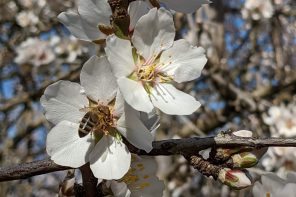What robots can learn from honey bees
by David Hargrove and Sheridan Tekosky
Honey bees, usually thought of for their contribution to agriculture, are making their debut into robotics. Mandyam Srinivasan, a faculty member at the University of Queensland in Australia, has been researching how bees may lend a hand, or a wing, in the development of unmanned aircrafts. With video cameras as eyes, and computers as brains, Srinivasan’s unmanned aircraft copy the honey bee’s visual system to successfully navigate.

An odometer is an essential feature to any vehicle, let alone an unmanned one. Your car uses wheel movement as an odometer to estimate distance travelled over time, but how can a flying vehicle without rotating wheels gauge distance? One answer is, global positioning satellite, GPS, in which a satellite tracks the aircraft to see how far it has flown. Satellites, however, are expensive. Another answer may come from Srinivasan’s experiments with the odometer that honey bees use. Honey bees use visual input to calculate distance they have travelled over a period of time. Srinivasan and colleagues investigated the relationship between a bee’s vision and its odometer; they found that the amount of visual contrast in the terrain that the bees flew over determines the distance the bees report they have flown. How did they do this? They trained bees to fly to two feeders that were equidistant from the hive. To get to one feeder, the bees had to fly over water; to get to the other, they had to fly over land. When the bees returned to their colony, they performed a waggle dance to communicate the distance and direction of the feeder to their nestmates. The bees that flew over the water performed waggle dances that advertised a food source closer to the hive than the bees that flew over the land. The foraging bees had perceived the feeder located across the water as closer, because they used visual contrast to measure the distance they had traveled, and water provides less visual contrast than land. Applying this method to unmanned aircrafts has the potential to save a great deal of time and money by reducing the necessity of costly satellites, which are required for GPS. By using video cameras, sensors and a computer that analyzes footage to tell how far an aircraft has flown, the application of this method to unmanned aircrafts may soon become a reality.
Unmanned aircrafts must also keep from colliding with walls when travelling through passageways. Think of yourself driving a car on the highway: you have to make sure you stay in your lane, while also looking out for other cars in nearby lanes. Bees have to deal with this same problem when they fly through narrow passages. Srinivasan and his team had noticed that bees fly precisely through the middle of windows and door-frames and they wanted to understand how the bees accomplish this task. So he and his team experimented with visual cues, to see how bees would center themselves in a passageway. In this experiment, Srinivasan and his team placed bees in a tunnel with black and white striped gratings on the sides of the walls, similar to a chess board (see image). The walls, however, could move towards the end of the tunnel, or backwards, at varying speeds, while the bee flew through the tunnel. When the grating didn’t move, the bees flew right down the middle of the tunnel. When the grating on one side of the tunnel moved in the direction that the bee flew (making it seem to move slower), the bee moved closer to that side. By moving closer to that side, the bee made the grating on both sides of the wall appear to pass by the bee at the same speed. When the grating on one side of the bee was moved in the opposite direction of the bee’s flight (making it seem to move faster), the bee moved away from that side. As before, the grating on either side would now seem to move by the bee at the same speed. By changing the speed of the gratings that flew by the bee, Srinivasan and his team were able to alter what path the bee perceived as equidistant from either side of the tunnel. This experiment indicates that bees not only use visual information for odometry, but also to center themselves in passageways.
This technique could be used in unmanned aircraft that need to stabilize themselves in narrow passages. With just two cameras and a computer, the aircraft can keep itself centered by changing its position to keep the image speed of the two walls equal3. These methods have been used in early robotic models that can avoid hazards while flying, such as Optoelectronic ocelli, which uses an insect-inspired visual system1. Though Srinivasan has yet to see his contributions to robotics spread commercially, these techniques have worked in early models. If honey bees become the template for the unmanned aircraft of the future, we will have yet another reason to thank the ever-astounding honey bee.
References
Srinivasan, M. V. (2011). “Honeybees as a model for the study of visually guided flight, navigation, and biologically inspired robotics.” Physiol. Rev. 91, 413-460
Tautz J, Zhang S, Spaethe J, Brockmann A, Si A, et al. (2004) “Honeybee Odometry: Performance in Varying Natural Terrain.” PLoS Biol 2(7): e211. doi:10.1371/journal.pbio.0020211
Srinivasan, M. V, Zhang S, Altwein A, Tautz J. (2000). “Honeybee Navigation: Nature and Calibration of the Odometer.” Science Mag Vol. 287 851-853








